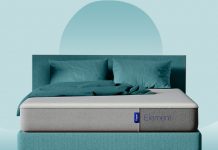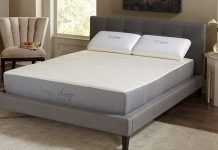Lying on a comfortable mattress is one of life’s simple pleasures. But have you ever wondered how often you should replace it? As we spend a third of our lives in bed, it’s essential to ensure we’re snoozing on a supportive and hygienic surface. In this article, we’ll shed light on the lifespan of a mattress and provide you with valuable insights to help you determine when it’s time for an upgrade. Say goodbye to restless nights and hello to rejuvenating slumbers!
Review contents
Factors to Consider
Quality of the Mattress
The quality of the mattress is one of the most important factors to consider when determining how often to replace it. A high-quality mattress is typically made with durable materials and designed to provide long-lasting comfort and support. On the other hand, a low-quality mattress may begin to deteriorate more quickly, leading to a shorter lifespan. When choosing a mattress, it’s important to invest in one that is known for its quality and durability to ensure that it will last for a significant period of time.
Usage and Maintenance
Another factor to consider is how the mattress is being used and maintained. Factors such as the frequency of use, the number of people sleeping on the mattress, and the presence of pets or children can all impact its lifespan. If a mattress is being used on a nightly basis by multiple people, it may experience more wear and tear and require replacement sooner. Additionally, proper maintenance, such as regular cleaning and the use of a mattress topper or protector, can help prolong the life of the mattress.
Weight and Body Type
The weight and body type of the individuals sleeping on the mattress can also affect its longevity. Heavier individuals may exert more pressure on the mattress, causing it to wear down more quickly. Similarly, individuals with larger body types may need a mattress with additional support to prevent sagging. It’s important to consider the weight and body type of the primary sleepers when determining how often a mattress should be replaced.
Allergies and Health Conditions
If you or someone in your household has allergies or specific health conditions, it’s important to consider these factors when determining how often to replace your mattress. Allergies to dust mites or mold can be exacerbated by an old, worn-out mattress that harbors these allergens. Additionally, individuals with back pain or spinal alignment issues may require a mattress that offers proper support and alignment. Those with sensitivities to chemicals or odors should also be mindful of the materials used in their mattress. Taking these factors into account will ensure that your mattress is not exacerbating any health issues.
Signs It’s Time for a Replacement
Visible Wear and Tear
One of the most obvious signs that it’s time to replace your mattress is if you notice visible wear and tear. This can include sagging, fraying, or visible damage to the mattress surface. If your mattress is showing signs of significant wear, it may not be providing the support and comfort that you need for a good night’s sleep.
Lack of Support and Comfort
Another sign that your mattress may need to be replaced is if you are no longer experiencing the same level of support and comfort as when the mattress was new. Over time, mattresses can lose their ability to properly contour to your body or provide support to your pressure points. If you find yourself waking up with aches and pains or feeling uncomfortable throughout the night, it may be time to start looking for a new mattress.
Worsening Allergies or Respiratory Issues
If you or someone in your household has been experiencing worsening allergies or respiratory issues, it may be due to your mattress. Over time, mattresses can accumulate allergens such as dust mites and mold, which can trigger allergy symptoms or respiratory problems. If you’ve ruled out other possible causes for these issues, it may be worth considering replacing your mattress to eliminate this potential source of allergens.
Sagging or Body Impressions
Another common sign that it’s time to replace your mattress is if you notice sagging or body impressions. Over time, the materials in a mattress can start to break down, causing it to lose its shape and support. If your mattress has visible sags or body impressions that don’t bounce back when you get up, it’s a good indication that the mattress has reached the end of its lifespan.
Age of the Mattress
Lastly, the age of the mattress is an important factor to consider when determining if it’s time for a replacement. While the lifespan of a mattress can vary depending on several factors, a good general guideline is to consider replacing your mattress every 7-10 years. However, it’s important to note that this is just an average and different mattress types may have different lifespans. If your mattress is reaching or surpassing the 10-year mark, it’s worth considering whether it’s still providing the level of comfort and support that you need.
This image is property of www.thespruce.com.
Average Lifespan of Different Mattress Types
Innerspring Mattresses
Innerspring mattresses are one of the most traditional types of mattresses, and they typically have an average lifespan of around 7-10 years. These mattresses are made up of coils or springs that provide support, with layers of padding or upholstery on top for comfort. Over time, the coils in an innerspring mattress can start to lose their elasticity and support, leading to sagging and decreased comfort. Regularly rotating and flipping the mattress can help extend its lifespan.
Memory Foam Mattresses
Memory foam mattresses have gained popularity in recent years for their ability to contour to the body and relieve pressure points. The average lifespan of a memory foam mattress is typically around 8-12 years. However, the specific lifespan can vary depending on factors such as the density and quality of the foam. Memory foam mattresses may experience some sagging or body impressions over time, but they generally hold up well and provide consistent support and comfort throughout their lifespan.
Latex Mattresses
Latex mattresses are known for their durability and resilience. These mattresses have an average lifespan of around 10-15 years. Latex is a natural and highly durable material, making latex mattresses resistant to sagging and body impressions. Additionally, latex mattresses have good motion isolation properties, making them a good choice for couples or individuals who are easily disturbed by movement during the night.
Hybrid Mattresses
Hybrid mattresses combine the best features of different mattress types, typically incorporating a combination of innerspring coils and memory foam or latex layers. The lifespan of a hybrid mattress can vary depending on the specific materials used, but they generally have an average lifespan of around 8-12 years. These mattresses offer a balance of support, comfort, and durability, making them a popular choice for many sleepers.
Effect of Weight and Body Type on Mattress Longevity
Lightweight Sleepers
For lightweight sleepers, mattresses with softer firmness levels and good pressure relief are generally recommended. Lighter individuals exert less pressure on the mattress, which can result in a longer lifespan. However, it’s still important to choose a high-quality mattress that can provide adequate support and comfort for your specific body type, as even lightweight individuals can experience sagging and wear over time.
Average Weight Sleepers
Average weight sleepers typically have more options when it comes to choosing a mattress. They can choose from a range of firmness levels depending on their personal preference, body type, and sleeping position. As with any sleeper, it’s important for average weight individuals to choose a mattress that offers a good balance of support and comfort, as well as durability to withstand their body weight over time.
Heavyweight Sleepers
Heavyweight sleepers, typically those weighing over 230 pounds, have different considerations when choosing a mattress. These individuals tend to exert more pressure on the mattress, which can lead to accelerated wear and tear. It’s important for heavier individuals to choose a mattress specifically designed to provide extra support and durability. This may include mattresses with thicker coil systems or higher-density foam layers to prevent excessive sagging and maintain proper spinal alignment.
This image is property of laylasleep.com.
Effects of Usage and Maintenance on Mattress Lifespan
Proper Cleaning and Care
Proper cleaning and care can significantly impact the lifespan of your mattress. Regularly vacuuming your mattress to remove dust and allergens can help prevent the accumulation of these substances over time. Additionally, using a mattress protector or topper can provide an extra layer of protection against spills, stains, and wear. Following the manufacturer’s guidelines for cleaning and care, such as avoiding excessive moisture and using gentle cleaning products, can help prolong the life of your mattress.
Use of Mattress Topper or Protector
Using a mattress topper or protector is not only helpful for protecting the mattress from spills and stains, but it can also contribute to its longevity. Mattress toppers or protectors can help distribute the weight and pressure evenly, reducing the risk of sagging or body impressions. They can also add an extra layer of comfort and support to your mattress, making it more durable and increasing its lifespan.
Rotating and Flipping the Mattress
Rotating and flipping your mattress can help prevent uneven wear and sagging in specific areas. Some mattresses are designed to be one-sided and should not be flipped, but can still benefit from regular rotation. This practice helps ensure that the mattress is used evenly and that pressure is distributed across different areas over time. Rotating and flipping the mattress every few months can help extend its lifespan and maintain its overall comfort and support.
Compatible Bed Base or Frame
The bed base or frame that your mattress is placed on can also impact its lifespan. A mattress that is not properly supported by a compatible base or frame may experience increased wear and sagging. It’s important to check the manufacturer’s recommendations for the appropriate bed base or frame to ensure that your mattress is properly supported. Using a foundation or platform bed with slats or a solid surface is generally recommended for most mattress types.
Allergies and Health Conditions Impact
Allergies to Dust Mites or Mold
If you or someone in your household suffers from allergies to dust mites or mold, it’s important to consider the impact of your mattress on these allergies. Over time, mattresses can accumulate dust mites and mold, leading to increased allergy symptoms. If your allergies have worsened or you’re experiencing symptoms such as sneezing, itchy eyes, or congestion, it may be a sign that your mattress needs to be replaced. Look for mattresses that are hypoallergenic and resistant to allergens if you are prone to these allergies.
Back Pain and Spinal Alignment
Back pain and spinal alignment issues are common concerns for many individuals. If you’re experiencing chronic back pain or discomfort, it may be worth considering whether your mattress is providing adequate support. An old or worn-out mattress may no longer be able to properly align your spine and alleviate pressure points, contributing to back pain. Choosing a mattress that offers proper support and pressure relief can help improve spinal alignment and alleviate back pain.
Sensitivity to Chemicals or Odors
Some individuals may be sensitive to certain chemicals used in the manufacturing of mattresses. This sensitivity can manifest as headaches, respiratory issues, or skin irritations. If you notice these symptoms and suspect that your mattress may be the cause, it may be necessary to replace it with one that is made from hypoallergenic and non-toxic materials. Look for mattresses that are CertiPUR-US certified or made with organic materials if you have sensitivities to chemicals or odors.
This image is property of www.i1.creditdonkey.com.
Quality Indicators
Manufacturer Warranty
The manufacturer warranty can provide insight into the expected lifespan and quality of a mattress. A longer warranty period is often an indicator that the manufacturer has confidence in the mattress’s durability and performance. It’s important to read and understand the details of the warranty, including any conditions or limitations.
Material Durability
The durability of the materials used in a mattress can significantly impact its lifespan. High-quality materials, such as high-density foams or durable coil systems, are more likely to hold up well over time and provide consistent support and comfort. When choosing a mattress, consider the quality and durability of the materials used to ensure that you’re investing in a long-lasting product.
Edge Support
Edge support refers to how well a mattress maintains its shape and support around the edges. A mattress with good edge support allows you to use the entire surface of the mattress without feeling like you might roll off. Strong edge support can also make it easier to get in and out of bed. When considering a mattress, pay attention to its edge support to ensure that it will provide consistent support and prevent sagging along the edges.
Motion Isolation
Motion isolation refers to how well a mattress absorbs and minimizes motion transfer. If you or your partner are easily disturbed by movement during the night, a mattress with good motion isolation can help ensure a more restful sleep. This is particularly important for individuals who share their bed with a partner or pet. When choosing a mattress, look for models that are known for their motion isolation properties to minimize disruptions during sleep.
Personal Preferences and Lifestyle Changes
Change in Sleeping Position
Your preferred sleeping position can impact the type of mattress that is most suitable for you. Different positions put varying amounts of pressure on different areas of the body. For example, side sleepers may benefit from a softer mattress that provides better pressure relief for the hips and shoulders, while back or stomach sleepers may prefer a firmer mattress that offers more support. If you have experienced a change in your sleeping position or preferences, it may be time to reassess whether your current mattress is still meeting your needs.
Partner Disturbance
If you share your bed with a partner, their movements during the night can impact your sleep quality. If you find yourself frequently waking up due to your partner’s movements, it may be worth considering a mattress with good motion isolation properties. This type of mattress can minimize the transfer of movement, allowing you and your partner to sleep undisturbed.
Finances and Budget
Another important consideration when determining how often to replace your mattress is your finances and budget. While a high-quality mattress is a worthwhile investment in your sleep quality and overall health, it’s important to choose a mattress that fits within your budget. Consider the lifespan and durability of the mattress in relation to its price to ensure that you’re getting the best value for your money.
Moving or Relocation
If you are planning to move or relocate in the near future, it may be worth considering whether it makes sense to replace your mattress before or after the move. Moving can be a good opportunity to assess the condition of your mattress and determine if it’s time for a replacement. Additionally, if you’re relocating to a new climate or environment, it’s important to consider how these changes may affect your mattress and its longevity.
This image is property of salemph.files.wordpress.com.
Frequency of Mattress Replacement
Every 7-10 Years as a General Guideline
As a general guideline, it is recommended to consider replacing your mattress every 7-10 years. This is based on the average lifespan of most mattresses and takes into account factors such as wear and tear, comfort, and support. However, it’s important to remember that this is just a guideline and individual circumstances may vary. Factors such as mattress type, usage, maintenance, and personal preferences should also be taken into consideration.
Shorter Lifespan Due to Specific Factors
Certain factors can contribute to a shorter lifespan for your mattress. For example, if you notice visible wear and tear, lack of support and comfort, or worsening allergies or respiratory issues, it may indicate that your mattress needs to be replaced earlier than the 7-10 year guideline. Additionally, factors such as heavier body weight, inadequate maintenance, or incompatible bed bases can also impact the longevity of your mattress. It’s important to be aware of these factors and adjust your replacement timeline accordingly.
Conclusion
When determining how often to replace your mattress, it’s important to consider a range of factors. The quality of the mattress, usage and maintenance, weight and body type, allergies and health conditions, and personal preferences all play a role in the lifespan of your mattress. Signs that it’s time for a replacement include visible wear and tear, lack of support and comfort, worsening allergies or respiratory issues, sagging or body impressions, and the age of the mattress. Different mattress types have varying lifespans, with innerspring mattresses lasting around 7-10 years, memory foam mattresses lasting around 8-12 years, latex mattresses lasting around 10-15 years, and hybrid mattresses lasting around 8-12 years. Weight and body type also impact mattress longevity, with lightweight sleepers generally having longer-lasting mattresses compared to heavyweight sleepers. Usage and maintenance, such as proper cleaning and care, the use of mattress toppers or protectors, rotating and flipping the mattress, and using a compatible bed base or frame, can also prolong the lifespan of your mattress. Allergies and health conditions should be considered when choosing and replacing a mattress. Quality indicators such as manufacturer warranty, material durability, edge support, and motion isolation can help determine the longevity of a mattress. Personal preferences and lifestyle changes, such as a change in sleeping position, partner disturbance, finances and budget, and moving or relocation, should also be taken into account. While a general guideline suggests replacing your mattress every 7-10 years, individual circumstances and specific factors may warrant a replacement earlier. Ultimately, it’s important to consider multiple factors and listen to your body’s comfort to determine when it’s time for a new mattress.
This image is property of www.i1.creditdonkey.com.




































